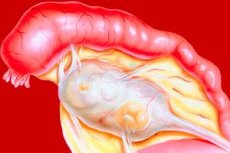Medical expert of the article
New publications
Pyosalpinx and tubo-ovarian abscess.
Last reviewed: 04.07.2025

All iLive content is medically reviewed or fact checked to ensure as much factual accuracy as possible.
We have strict sourcing guidelines and only link to reputable media sites, academic research institutions and, whenever possible, medically peer reviewed studies. Note that the numbers in parentheses ([1], [2], etc.) are clickable links to these studies.
If you feel that any of our content is inaccurate, out-of-date, or otherwise questionable, please select it and press Ctrl + Enter.

Pyosalpinx is a collection of pus in the fallopian tube during salpingitis.
Tuboovarian abscess is a cavity in the area of the fallopian tube and ovary, containing pus and separated from the surrounding tissues by a pyogenic membrane. A pronounced clinical picture is observed when the abscess ruptures and its contents enter the abdominal cavity.
Symptoms pyosalpinx and tubo-ovarian abscess.
- pain in the lower abdomen before admission to hospital;
- generalized pain throughout the abdomen when pus enters the abdominal cavity;
- irradiation of pain to the upper quadrant of the abdomen, lower back;
- increased pain with movement;
- forced body position;
- chills, tachycardia, decreased blood pressure;
- general malaise, weakness, loss of appetite;
- nausea, vomiting, diarrhea;
- fever (38-40° C);
- purulent vaginal discharge;
- positive symptoms of peritoneal irritation;
- increased pain with displacement of the cervix;
- palpation of a tumor-like formation on one or both sides of the uterus, painful, with unclear contours.
Diagnostics pyosalpinx and tubo-ovarian abscess.
When making a diagnosis, it is necessary to take into account:
- anamnesis data (presence of inflammatory diseases of the genitals in the past, foci of chronic infection in women);
- objective examination data that allow to identify a purulent-inflammatory process in the pelvis; during laboratory blood tests, leukocytosis with a shift towards polymorphonuclear cells, an increase in LII to 10, ESR to 30 mm/h, and sometimes moderate anemia are determined.
Laparoscopy allows to verify the diagnosis and, in some cases, perform surgical treatment.
What do need to examine?
Differential diagnosis
Differential diagnosis of pyosalpinx and tuboovarian abscess:
- intrauterine or ectopic pregnancy;
- torsion of the ovarian cystadenoma pedicle or subserous myomatous node of the uterus;
- appendicular infiltrate.
Who to contact?
Treatment pyosalpinx and tubo-ovarian abscess.
Accurate diagnosis and exclusion of abscess wall rupture are extremely important for treatment selection.
At the initial stages, conservative therapy is carried out, including:
- bed rest;
- correction of water and electrolyte balance disorders, immunomodulators;
- sedatives, desensitizing agents;
- intravenous antibiotics, metronidazole;
- if an IUD is present, its removal;
- drainage of inflammatory formations and pelvic abscesses.
Indications for surgical treatment:
- lack of effect from intensive conservative therapy within 4 hours of its implementation;
- perforation of pyosalpinx or tubo-ovarian abscess, diffuse peritonitis;
- infectious toxic shock.
The scope of surgical treatment is determined individually. Extirpation or supravaginal amputation of the uterus with unilateral or bilateral removal of appendages is performed in the following clinical situations:
- in case of severe condition of the patient and formation of multiple intra-abdominal abscesses;
- with diffuse purulent peritonitis;
- in case of primary involvement of the uterus in the process (after childbirth, abortions, IUD);
- for bilateral tubo-ovarian abscesses in the pelvis.
At a young age, hysterectomy should be the exception rather than the rule. The smallest possible opportunity to preserve ovarian tissue should be used.
Drugs


 [
[